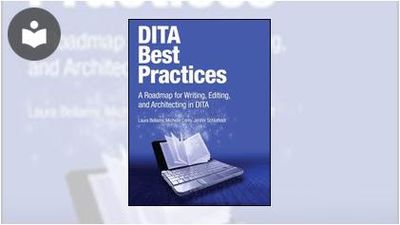DITA Best Practices: A Roadmap for Writing, Editing, and Architecting in DITA
- 4h 10m
- Jenifer Schlotfeldt, Laura Bellamy, Michelle Carey
- IBM Press
- 2012
Darwin Information Typing Architecture (DITA) is today’s most powerful toolbox for constructing information. By implementing DITA, organizations can gain more value from their technical documentation than ever before. Now, three DITA pioneers offer the first complete roadmap for successful DITA adoption, implementation, and usage.
Drawing on years of experience helping large organizations adopt DITA, the authors answer crucial questions the “official” DITA documents ignore, including: Where do you start? What should you know up front? What are the pitfalls in implementing DITA? How can you avoid those pitfalls?
The authors begin with topic-based writing, presenting proven best practices for developing effective topics and short descriptions. Next, they address content architecture, including how best to set up and implement DITA maps, linking strategies, metadata, conditional processing, and content reuse. Finally, they offer “in the trenches” solutions for ensuring quality implementations, including guidance on content conversion.
Coverage includes:
- Knowing how and when to use each DITA element–and when not to
- Writing “minimalist,” task-oriented information that quickly meets users’ needs
- Creating effective task, concept, and reference topics for any product, technology, or service
- Writing effective short descriptions that work well in all contexts
- Structuring DITA maps to bind topics together and provide superior navigation
- Using links to create information webs that improve retrievability and navigation
- Gaining benefits from metadata without getting lost in complexity
- Using conditional processing to eliminate redundancy and rework
- Systematically promoting reuse to improve quality and reduce costs
- Planning, resourcing, and executing effective content conversion
- Improving quality by editing DITA content and XML markup
If you’re a writer, editor, information architect, manager, or consultant who evaluates, deploys, or uses DITA, this book will guide you all the way to success.
About the Authors
Laura Bellamy is an Information Architect at VMware, Inc. and a technical communications instructor at University of California Santa Cruz Extension. Laura has been a long-time DITA champion, working at IBM during the adoption and proliferation of DITA. Throughout her career, she has worked on many facets of DITA implementation and now dreams in XML.
Michelle Carey is a technical editor at IBM and a technical communications instructor at University of California Santa Cruz Extension. Michelle has taught IBM teams and users’ groups about best practices for authoring in DITA, topic-based writing, writing for translation, editing user interfaces, and writing effective error messages. She is also a coauthor of the book Developing Quality Technical Information.
Jenifer Schlotfeldt is a project leader, information developer, and technical leader at IBM and a technical communications instructor at the University of California Santa Cruz Extension. She has been authoring, testing, and teaching DITA since 2003. She has converted documentation to DITA, authored new content in DITA, contributed to new DITA specializations, and created many training materials for different facets of DITA authoring.
In this Book
-
DITA Best Practices―A Roadmap for Writing, Editing, and Architecting in DITA
-
Topic-Based Writing in DITA
-
Task Topics
-
Concept Topics
-
Reference Topics
-
Short Descriptions
-
DITA Maps and Navigation
-
Linking
-
Metadata
-
Conditional Processing
-
Content Reuse
-
Converting Content to DITA
-
DITA Code Editing
-
Content Editing




